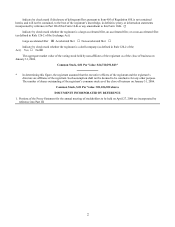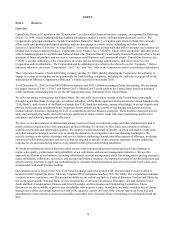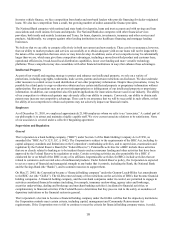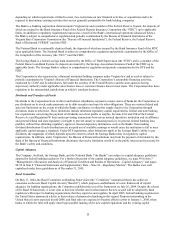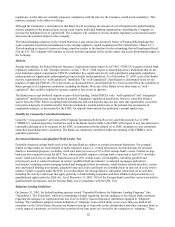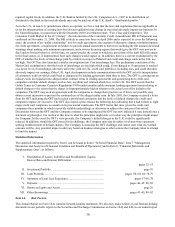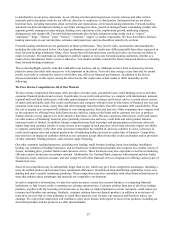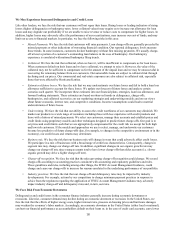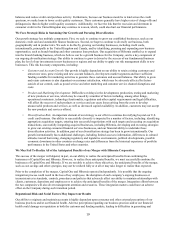Capital One 2005 Annual Report Download - page 21
Download and view the complete annual report
Please find page 21 of the 2005 Capital One annual report below. You can navigate through the pages in the report by either clicking on the pages listed below, or by using the keyword search tool below to find specific information within the annual report.regulations. As the rules are currently proposed, compliance with the rules by the Company would not be mandatory. This
meline continues to be subject to change. ti
Although the Committee’ s stated intent is that Basel II will not change the amount of overall capital in the global banking
system, adoption of the proposed new accord could require individual banking organizations, including the Company, to
increase the minimum level of capital held. The Company will continue to closely monitor regulatory action on this matter
and assess the potential impact to the Company.
The federal banking regulators in the United States have also released an Advanced Notice of Proposed Rulemaking that
seeks comments on potential amendments to the existing regulatory capital regulations in the United States (“Basel 1A”).
This rulemaking is expected to proceed along a timeline similar to the timeline for the rulemaking that will implement Basel
II in the US. The Company will continue to closely monitor regulatory action on this matter and assess the potential impact to
the Company.
F
DICIA
Among other things, the Federal Deposit Insurance Corporation Improvement Act of 1991 (“FDICIA”) requires federal bank
regulatory authorities to take “prompt corrective action” (“PCA”) with respect to insured depository institutions that do not
meet minimum capital requirements. FDICIA establishes five capital ratio levels: well-capitalized, adequately-capitalized,
undercapitalized, significantly undercapitalized and critically undercapitalized. As of December 31, 2005, each of the Banks
met the requirements for a “well-capitalized” institution. The “well-capitalized” classification is determined solely for the
purposes of applying FDICIA’ s PCA provisions, as discussed below, and should not be viewed as describing the condition or
future prospects of a depository institution, including the Banks. Were any of the Banks to lose their status as “well-
capitalized” they could be required to increase capital or lose access to deposits.
The Banks may accept brokered deposits as part of their funding. Under FDICIA, only “well-capitalized” and “adequately-
capitalized” institutions may accept brokered deposits. Adequately-capitalized institutions, however, must first obtain a
waiver from the FDIC before accepting brokered deposits, and such deposits may not pay rates that significantly exceed the
rates paid on deposits of similar maturity from the institution’ s normal market area or the national rate on deposits of
comparable maturity, as determined by the FDIC, for deposits from outside the institution’ s normal market area.
Liability for Commonly-Controlled Institutions
Under the “cross-guarantee” provision of the Financial Institutions Reform, Recovery and Enforcement Act of 1989
(“FIRREA”), insured depository institutions such as the Banks may be liable to the FDIC with respect to any loss incurred or
reasonably anticipated to be incurred, by the FDIC in connection with the default of, or FDIC assistance to, any commonly
controlled insured depository institution. The Banks are commonly controlled within the meaning of the FIRREA cross-
uarantee provision. g
vestment Limitation and Qualified Thrift Lender Test In
Federally-chartered savings banks such as the Savings Bank are subject to certain investment limitations. For example,
federal savings banks are not permitted to make consumer loans (i.e., certain open-end or closed-end loans for personal,
family or household purposes, excluding credit card loans) in excess of 35% of the savings bank’ s assets. Federal savings
banks are also required to meet the QTL Test, which generally requires a savings bank to maintain at least 65% “portfolio
assets” (total assets less (i) specified liquid assets up to 20% of total assets, (ii) intangibles, including goodwill and
(iii) property used to conduct business) in certain “qualified thrift investments” (residential mortgages and related
investments, including certain mortgage backed and mortgage related investments, small business related securities, certain
state and federal housing investments, education loans and credit card loans) on a monthly basis in nine out of every twelve
months. Failure to qualify under the QTL Test could subject the Savings Bank to substantial restrictions on its activities,
including the activity restrictions that apply generally to bank holding companies and their affiliates and potential loss of
grandfathered rights under the GLB Act. As of December 31, 2005, 76% of the Savings Bank’ s portfolio assets were held in
qualified thrift investments, and the Savings Bank was in compliance with the QTL Test.
Subprime Lending Guidelines
On January 31, 2001, the federal banking agencies issued “Expanded Guidance for Subprime Lending Programs” (the
“Guidelines”). The Guidelines, while not constituting a formal regulation, provide guidance to the federal bank examiners
regarding the adequacy of capital and loan loss reserves held by insured depository institutions engaged in “subprime”
lending. The Guidelines adopted a broad definition of “subprime” loans which likely covers more than one-third of all
consumers in the United States. Because our business strategy is to provide credit card products and other consumer loans to
a wide range of consumers, we believe that a portion of our loan assets are viewed by the examiners as “subprime.” Thus,
12


